Wine classification encompasses a comprehensive system that categorizes wines based on strict criteria, taking into account factors such as geographic origin, vinification methods, taste sweetness, vintage, and grape varieties.
At the heart of this grouping is the appellation concept—a designation used primarily to identify where the grapes for a wine were grown. Appellations serve as a guide to quality and style, and they can significantly influence the value and perception of the wine.
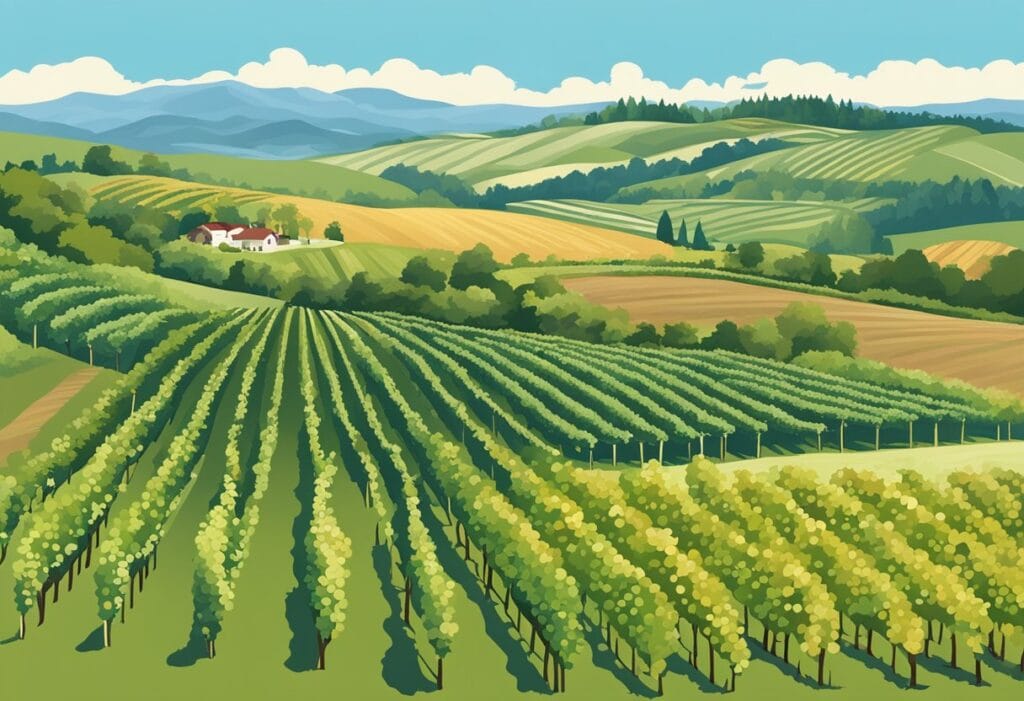
Understanding the intricacies of global appellation systems offers insights into the diverse practices upheld by wine-producing countries, which sometimes have protected statuses within their legal frameworks. This legal aspect helps maintain the integrity and tradition of regional winemaking practices.
By becoming familiar with notable wine regions and appellations, enthusiasts and connoisseurs can better appreciate the nuances that geography and terroir bring to a bottle of wine.
Key Takeaways
- Wine classification is determined by region, production method, and grape varieties used.
- Appellations indicate the geographic origin and influence wine quality and character.
- Legal regulations enforce wine classification standards, preserving tradition.
Understanding Wine Classification
Wine classification offers a structured way to understand and appreciate wines. It involves categorizing wines based on various criteria including the grape variety, vintage, and the region of production. This structure not only guides consumers but also preserves winemaking traditions.
Defining Wine Classification
Wine classification refers to the method of categorizing wines to denote their quality, style, and origin. At its core, the classification system serves to inform you about the tradition and standard of the wine you are choosing. Quality wines are often distinguished from table wines, with the former having stricter regulations regarding production and origin.
Classification Systems Overview
Different countries have developed their own wine classification systems to earmark the prowess of their winemaking heritage. For instance, France has its Appellation d’Origine Contrôlée (AOC), whereas Italy uses Denominazione di Origine Controllata (DOC). These classifications often reflect the terroir—the natural environment where the wine is produced, including factors like soil, topography, and climate—which is crucial to the quality and uniqueness of a wine.
Wine Label Information
Your wine’s label is a treasure trove of information provided by the classification system. Here, you’ll find essential details such as the grape variety, vintage, alcohol content, and level of sweetness. This info can help you make informed decisions and discover wines that align with your preferences.
Terroir and Classification
The notion of terroir plays a significant role in wine classification. The character of the wine is heavily influenced by its place of origin, which is why many classification systems are based on geographic indications. This link between the land and the wine ensures that each bottle carries the unique signature of its origin, a concept steeped in tradition and winemaking style.
By exploring industrial revolution winemaking, you gain insight into how historical advancements have shaped modern classification systems. Similarly, delving into the roots of neolithic wine making can illustrate how long-standing traditions continue to influence wine classification today.
Moreover, the refined practices from the renaissance wine making period still resonate in the systematic approach of categorizing wines. Understanding these concepts will enhance your ability to select and enjoy wines that truly resonate with your palate and preferences.
Global Appellation Systems
Appellation systems serve to classify wines by regulated geographical origin and specify production standards to ensure quality and authenticity.
European Union Legislation
European Union (EU) legislation concerning wine appellations is robust, aimed at protecting the names and qualities of wines. Under EU law, the Protected Designation of Origin (PDO) stands as a key element for wines that are produced, processed, and prepared in a given geographical area using recognized know-how. Italy’s “Denominazione di Origine Controllata e Garantita” (DOCG) and France’s “Appellation d’Origine Contrôlée” (AOC) are prime examples of this stringent classification, indicating top-tier wines that adhere to the strictest regulations regarding grape varieties and winemaking practices.
The American Viticultural Area (AVA)
Within the United States, the American Viticultural Area (AVA) system identifies wine regions on the basis of geographical features with boundaries defined by the Alcohol and Tobacco Tax and Trade Bureau. Criteria for an AVA designation require evidence that the area is significantly distinguishable by geographic features and that growing conditions, such as climate and soil, will impact the wine produced.
For instance, California’s Napa Valley, classified as an AVA, is world-renowned for producing high-quality wines largely influenced by its unique terroir.
Other International Appellations
Beyond the EU and US, several countries have adopted their own appellation systems, reflecting their commitment to wine heritage and quality. Chile, Argentina, South Africa, and Australia have established systems to define wine regions and production methods.
Australia, particularly, uses the Australian Geographical Indications to categorize wine regions at the country, zone, and region levels. These international appellation systems help consumers identify the origin and quality of wines, with each system custom-tailored to the nation’s wine industry and regional characteristics.
Notable Wine Regions and Appellations
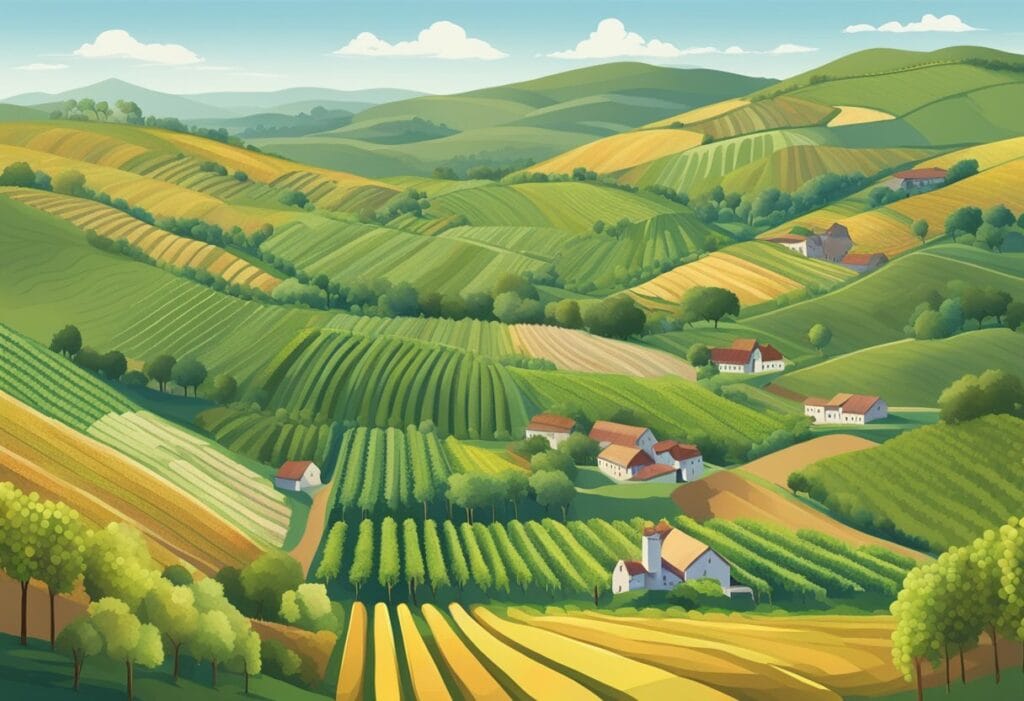
In exploring the world of wines, certain regions stand out for their exceptional appellation systems and traditions. These regions have honed their craft over centuries, establishing themselves as benchmarks of quality in the wine industry.
France’s Prestigious Appellations
France sets the standard with rigorous AOP/AOC classification systems. Champagne, strictly defined both as a sparkling wine and an appellation, hails from the Champagne region. It epitomizes luxury and celebration.
The reds and whites of Bordeaux showcase a rich history; from the robust reds of Saint-Émilion and Graves to the sweet Sauternes, each tells a story of the vineyard’s terroir and tradition. It’s the embodiment of French viticulture, where the harmony of grapes and the earth are celebrated.
Italy’s Wine Heritage
Italy takes pride in their DOC and DOCG classifications, ensuring that wines like Chianti Classico adhere to stringent quality standards and region-specific grape usage. The rolling hills of Tuscany birth wines of such stature and poise, expressing a sense of place through every bottle. Chianti, in its traditional straw baskets, represents not just a wine, but a legacy woven into Italian culture.
Spain’s Diverse Portfolio
Moving to Spain, variety is key. The bold and age-worthy reds of Rioja sit alongside the unique complexities of Sherry and the festive bubbles of Cava. Each wine reflects the regions’ diverse climates and wine-making approaches that range from the traditional, oak-aged classics to modern, vibrant interpretations, all rooted in Spanish tradition.
Other European Highlights
Beyond these giants, other European regions contribute notable appellations. Germany is famed for its Prädikatswein and tiers like Spätlese, which indicate ripeness and sweetness levels. The Tokaj-Hegyalja region in Hungary, known for its lusciously sweet Tokaji, demonstrates the intricate tapestry of European viticulture. Each region is a testament to the continent’s rich tapestry of wine-making history.
In your journey through the storied landscapes of wine, you’ll discover that these appellations are more than just names; they are a gateway to understanding the heritage and meticulous craftsmanship that shape the world’s finest wines.
Wine Styles and Varieties
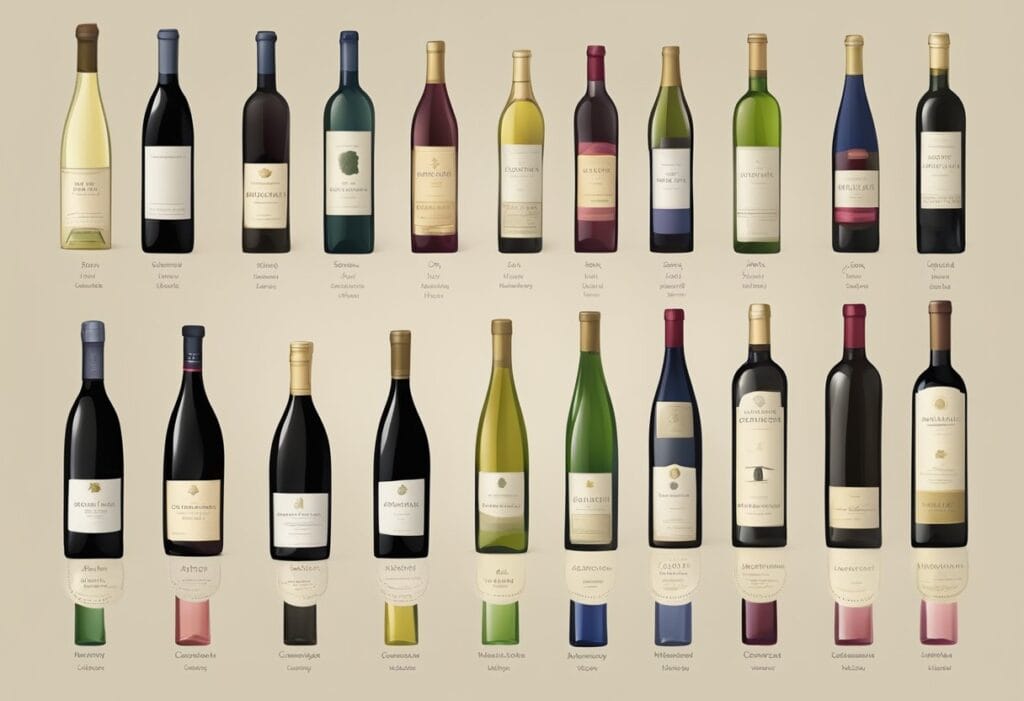
Exploring the diverse world of wines, you’ll discover a rich panorama defined by style and grape variety. These classifications are pivotal in understanding the nuances that make each wine unique.
Exploring Red and White Wines
Red wines are known for their robust flavors and deep color, typically achieved through fermenting the juice with the grape skins. Among the most celebrated reds are Cabernet Sauvignon and Pinot Noir, each offering distinctive taste profiles based on the regions they are designated.
White wines, on the other hand, are fermented without grape skins, resulting in a lighter color and a range of flavor from zesty citrus to rich and creamy. Chardonnay, for instance, is a versatile variety that reflects the unique characteristics of its state or region of origin.
Sparkling, Fortified, and Dessert Wines
For occasions that call for a toast, sparkling wines like Champagne or Cava fizz with effervescent life. The production process involves a secondary fermentation that traps carbon dioxide, creating those signature bubbles.
Dessert wines span the spectrum from Ice Wine, concentrated and sweet from frozen grapes, to the complex, botrytized wines like Beerenauslese, enriched by Noble Rot caused by the fungus Botrytis cinerea.
Fortified wines are elevated with the addition of spirits, resulting in long-lived classics such as Port and Sherry. The higher alcohol content of these fortified wines ensures their ability to age gracefully, developing intricate layers over time.
Unique Wine Characteristics
Wine appreciation often involves noting the nuances that grape varieties bestow. The Grand Cru classification, for example, denotes wines of the highest quality from distinguished vineyards in France. Each wine style you encounter may express a wide array of sensory details, influenced by climate, soil, and winemaking techniques.
By exploring the intersection of wine styles, grape varieties, and appellations, you heighten your understanding and enjoyment of this timeless beverage. Whether indulging in a red wine with dinner or sipping a delicate white wine on a sunny afternoon, the journey through wine’s classification and variety is as rewarding as it is flavorful.
Wine Regulation and Legal Aspects

In the realm of winemaking, legal regulations are pivotal in ensuring the quality and authenticity of wines. They govern everything from grape growing to labeling, maintaining both tradition and standards across the industry.
Quality Control and Legal Framework
Appellation of origin is a key concept in wine regulation, providing you with a guarantee of where the grapes for your wine were grown and often how they were grown. In France, the Appellation d’Origine Contrôlée (AOC) system sets stringent rules for winemaking practices and grape variety usage. For example, an AOC wine must adhere to specific criteria defined by the governing bodies, ensuring a standard of quality wine.
Moving beyond France, the European Union uses a similar system known as Protected Designation of Origin (PDO), which includes the French AOC and the Indication Géographique Protégée (IGP) – a category with a bit more flexibility in production methods. These frameworks play a crucial role in maintaining both the cultural heritage and the high quality of European wines.
Impact of Regulation on Wine Production
Regulations don’t only preserve quality; they also influence the entire wine production process. The historical treaties, such as the Treaty of Versailles, have influenced wine laws and classifications to prevent fraud in wine trade. The French Institut National de l’Origine et de la Qualité (INAO), for instance, enforces these regulations rigorously, ensuring that AOC and IGP wines meet all legal requirements before reaching your glass.
Stringent regulations can sometimes be seen as a restriction by winemakers, yet they are critical for you as a consumer. They safeguard wine’s integrity and support trust in wine labeling, allowing you to make informed choices about the wines you purchase. Regulations assure that the term “appellation of origin” on a label corresponds with strict rules and a controlled quality level.
The Future of Wine Classification
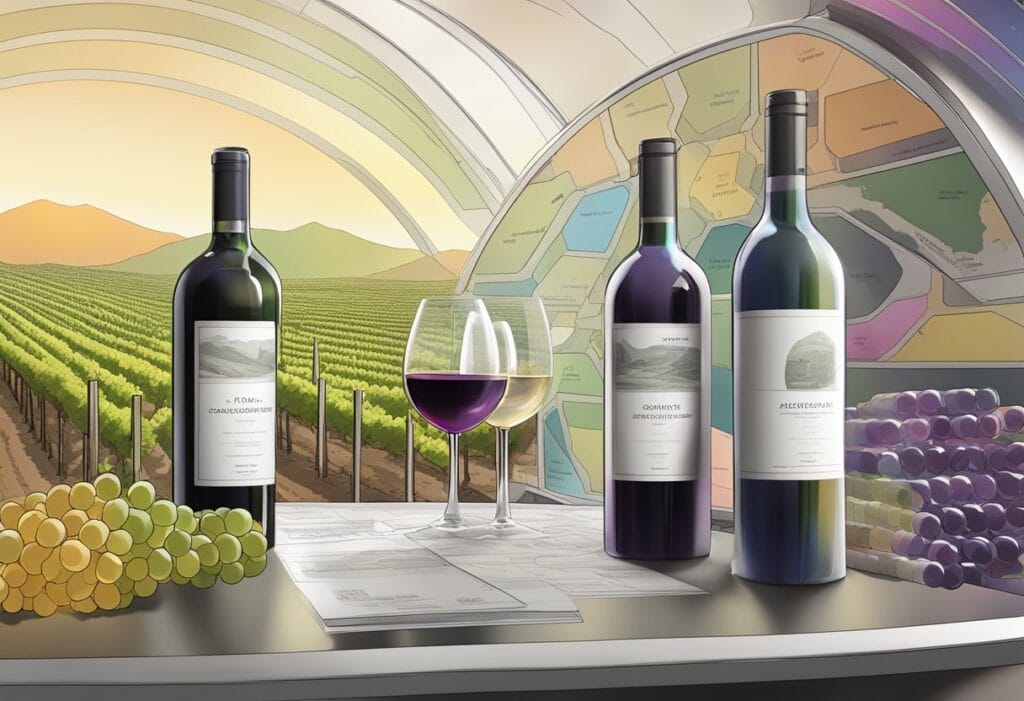
As you explore the wine world, it’s important to consider how emerging trends and ongoing debates will shape the way wines are classified in the future. This insight will guide your understanding and appreciation of wine labels, designations, and appellations.
Trends and Innovations
Technology plays a pivotal role in advancing the wine classification system. Future labels may incorporate smart technology that allows you to scan a wine label with your smartphone to verify authenticity and provenance. With this innovation, Denominación de Origen (DO) and Protected Designation of Origin (PDO) information becomes instantly accessible, ensuring you’re informed about the geographical indication of your wine.
Advances in DNA profiling of grapevines could change the game for regional wine classification, making the identification of grape varieties more accurate. This could lead to more precise and potentially new categories based on genetic grape profiles, offering a modern twist on tradition.
Challenges and Debates
There’s an ongoing debate on the balance between preserving regional traditions and adapting to globalization. As wine labels serve as a key indicator of quality and origin, the tug-of-war between innovation and tradition could lead to contentious changes in labeling regulations.
Food and wine pairing has always been a part of culinary culture, yet discussions about label information might adjust to better suggest food pairings directly on the bottle, leveraging PDO and geographical indication as indicators of the wine’s character.
Climate change poses a significant challenge, potentially redefining regional characteristics that have long been foundational to appellation systems. Maintaining the integrity of appellations like Denominación de Origen amidst a changing environment will be a contentious aspect of future wine classifications.
The evolving conversation about sustainability and environmental practices might prompt new designation criteria, emphasizing organic or biodynamic methods. As with many of these changes, adaptations will likely surface on encyclopedia pages, like that from Wikipedia, as updated articles reflecting the progress in wine classification standards.
Wine Education and Appreciation
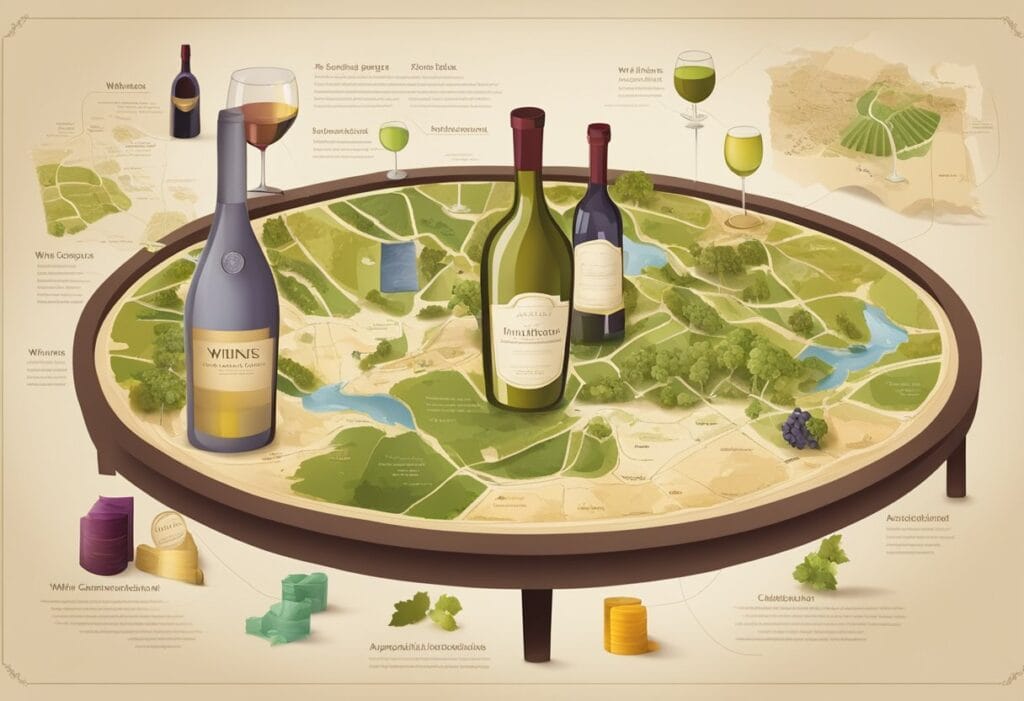
When venturing into the world of wines, understanding the concept of terroir is fundamental. Terroir refers to the unique characteristics of geography, geology, and climate of a certain place, affecting the taste and quality of grapes. Each wine appellation, or the legally defined and protected geographical indication used to identify where the grapes for a wine were grown, is closely tied to its regional terroir.
To truly appreciate wine, consider the appellations of North America or the historic vineyards of Hungary, where the combination of soil, climate, and local grape varieties contribute to a wine’s individuality. This appreciation is akin to how one might study a bible—with dedication and attention to detail—delving into profound depths with every sip.
Pairing wine with food is another aspect of education and appreciation, enhancing flavors and elevating dining experiences. For instance, a robust wine from a prestigious regional appellation may complement a hearty meat dish, while a light, crisp wine might be the perfect match for a delicate seafood entrée.
Learning the nuances of tasting can elevate your understanding and enjoyment of wine significantly. A structured approach to tasting can help you identify the bouquet, taste profile, and body of the wine. For guiding your journey, consider using a wine tasting guide to help you discern and savor the various aspects of wine tasting.
By grasping these elements—the impact of terroir, the significance of appellations, and the art of pairing and tasting—you build a foundation for wine appreciation that can last a lifetime.

